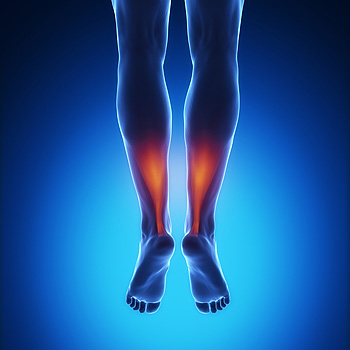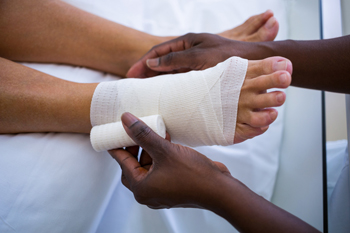Connect With Us
Blog
Items filtered by date: September 2020
What Can Cause Achilles Tendon Pain?
 There are multiple conditions that can cause pain in the Achilles tendon, a tough band of tissue that connects the calf muscles to the heel bone. Achilles tendonitis is an inflammation of the tendon, and tends to have a quick onset and pain that may last up to six weeks. Achilles tendinosis is a degeneration of the tendon and is noninflammatory. It is often caused by overuse. Paratenonitis is an inflammation of the tissue that surrounds the Achilles tendon. Insertional Achilles tendinopathy is the inflammation and subsequent degeneration of tendon fibers that insert on the back of the heel bone. If you are experiencing pain at the back of the ankle or in the lower calf, it is suggested that you visit a podiatrist to receive a proper diagnosis and treatment.
There are multiple conditions that can cause pain in the Achilles tendon, a tough band of tissue that connects the calf muscles to the heel bone. Achilles tendonitis is an inflammation of the tendon, and tends to have a quick onset and pain that may last up to six weeks. Achilles tendinosis is a degeneration of the tendon and is noninflammatory. It is often caused by overuse. Paratenonitis is an inflammation of the tissue that surrounds the Achilles tendon. Insertional Achilles tendinopathy is the inflammation and subsequent degeneration of tendon fibers that insert on the back of the heel bone. If you are experiencing pain at the back of the ankle or in the lower calf, it is suggested that you visit a podiatrist to receive a proper diagnosis and treatment.
Achilles tendon injuries need immediate attention to avoid future complications. If you have any concerns, contact one of our podiatrists of Houston Foot and Ankle. Our doctors can provide the care you need to keep you pain-free and on your feet.
What Is the Achilles Tendon?
The Achilles tendon is a tendon that connects the lower leg muscles and calf to the heel of the foot. It is the strongest tendon in the human body and is essential for making movement possible. Because this tendon is such an integral part of the body, any injuries to it can create immense difficulties and should immediately be presented to a doctor.
What Are the Symptoms of an Achilles Tendon Injury?
There are various types of injuries that can affect the Achilles tendon. The two most common injuries are Achilles tendinitis and ruptures of the tendon.
Achilles Tendinitis Symptoms
- Inflammation
- Dull to severe pain
- Increased blood flow to the tendon
- Thickening of the tendon
Rupture Symptoms
- Extreme pain and swelling in the foot
- Total immobility
Treatment and Prevention
Achilles tendon injuries are diagnosed by a thorough physical evaluation, which can include an MRI. Treatment involves rest, physical therapy, and in some cases, surgery. However, various preventative measures can be taken to avoid these injuries, such as:
- Thorough stretching of the tendon before and after exercise
- Strengthening exercises like calf raises, squats, leg curls, leg extensions, leg raises, lunges, and leg presses
If you have any questions please feel free to contact our offices located in Kingwood, Humble, The Woodlands, and Conroe, TX . We offer the newest diagnostic tools and technology to treat your foot and ankle needs.
Wounds on the Feet may Heal Slowly
 Foot ulcers can be a common occurrence in diabetic patients. This type of wound generally heals slowly, which may be a result of elevated blood glucose levels, hypertension, and hypercholesterolemia. Proper wound care and management can consist of eliminating existing pressure from shoes that are worn. Some patients find it helpful to wear special footwear or therapeutic boots. Keeping the wound clean is beneficial in accelerating the healing process, and it may help to moisturize the surrounding area. Improving circulation is also said to promote faster healing as well as diminish pain. If you have wounds on your feet, it is advised that you speak to a podiatrist as quickly as possible who can recommend the appropriate treatment methods and help prevent infection.
Foot ulcers can be a common occurrence in diabetic patients. This type of wound generally heals slowly, which may be a result of elevated blood glucose levels, hypertension, and hypercholesterolemia. Proper wound care and management can consist of eliminating existing pressure from shoes that are worn. Some patients find it helpful to wear special footwear or therapeutic boots. Keeping the wound clean is beneficial in accelerating the healing process, and it may help to moisturize the surrounding area. Improving circulation is also said to promote faster healing as well as diminish pain. If you have wounds on your feet, it is advised that you speak to a podiatrist as quickly as possible who can recommend the appropriate treatment methods and help prevent infection.
Wound care is an important part in dealing with diabetes. If you have diabetes and a foot wound or would like more information about wound care for diabetics, consult with one of our podiatrists from Houston Foot and Ankle. Our doctors will assess your condition and provide you with quality foot and ankle treatment.
What Is Wound Care?
Wound care is the practice of taking proper care of a wound. This can range from the smallest to the largest of wounds. While everyone can benefit from proper wound care, it is much more important for diabetics. Diabetics often suffer from poor blood circulation which causes wounds to heal much slower than they would in a non-diabetic.
What Is the Importance of Wound Care?
While it may not seem apparent with small ulcers on the foot, for diabetics, any size ulcer can become infected. Diabetics often also suffer from neuropathy, or nerve loss. This means they might not even feel when they have an ulcer on their foot. If the wound becomes severely infected, amputation may be necessary. Therefore, it is of the upmost importance to properly care for any and all foot wounds.
How to Care for Wounds
The best way to care for foot wounds is to prevent them. For diabetics, this means daily inspections of the feet for any signs of abnormalities or ulcers. It is also recommended to see a podiatrist several times a year for a foot inspection. If you do have an ulcer, run the wound under water to clear dirt from the wound; then apply antibiotic ointment to the wound and cover with a bandage. Bandages should be changed daily and keeping pressure off the wound is smart. It is advised to see a podiatrist, who can keep an eye on it.
If you have any questions, please feel free to contact our offices located in Kingwood, Humble, The Woodlands, and Conroe, TX . We offer the newest diagnostic and treatment technologies for all your foot care needs.

